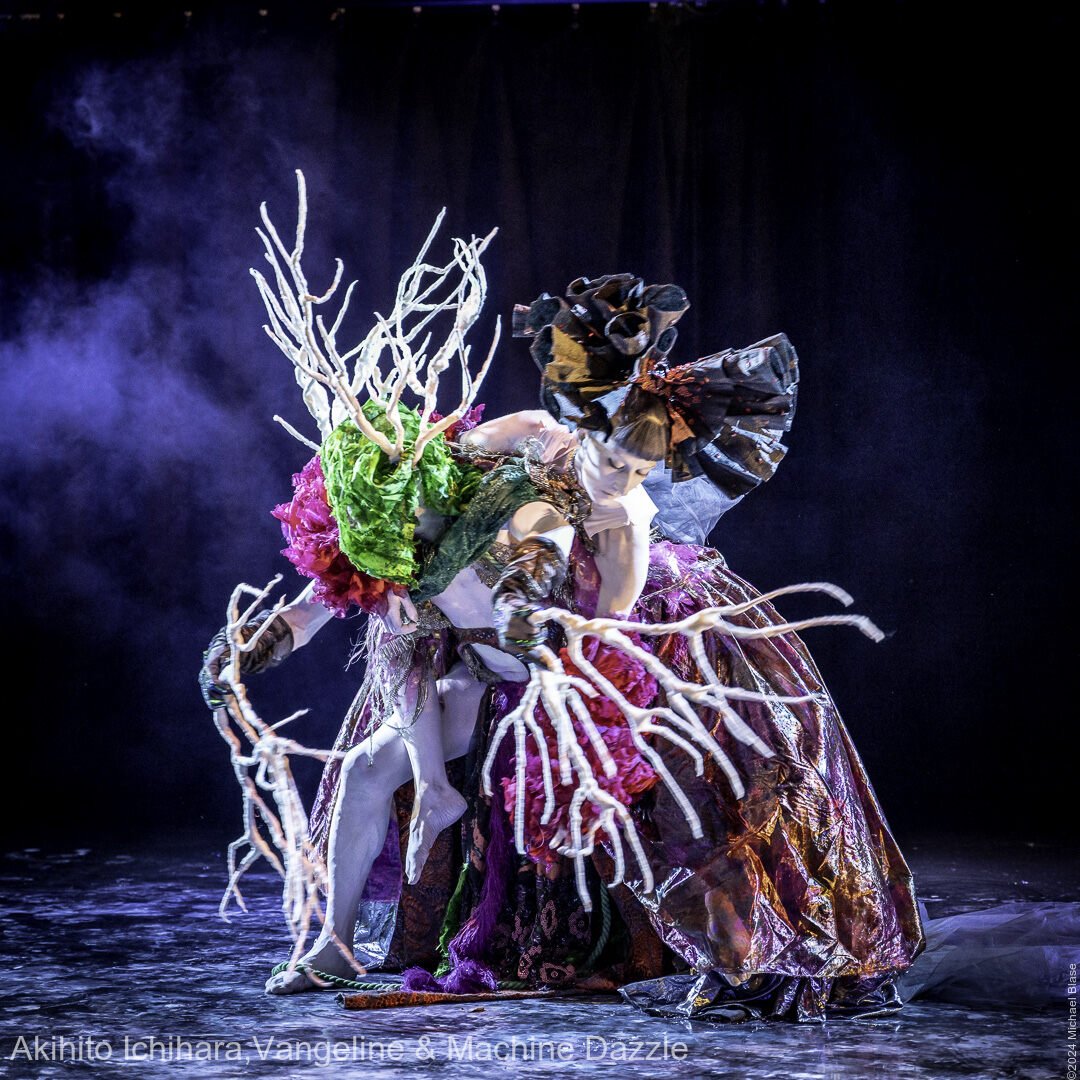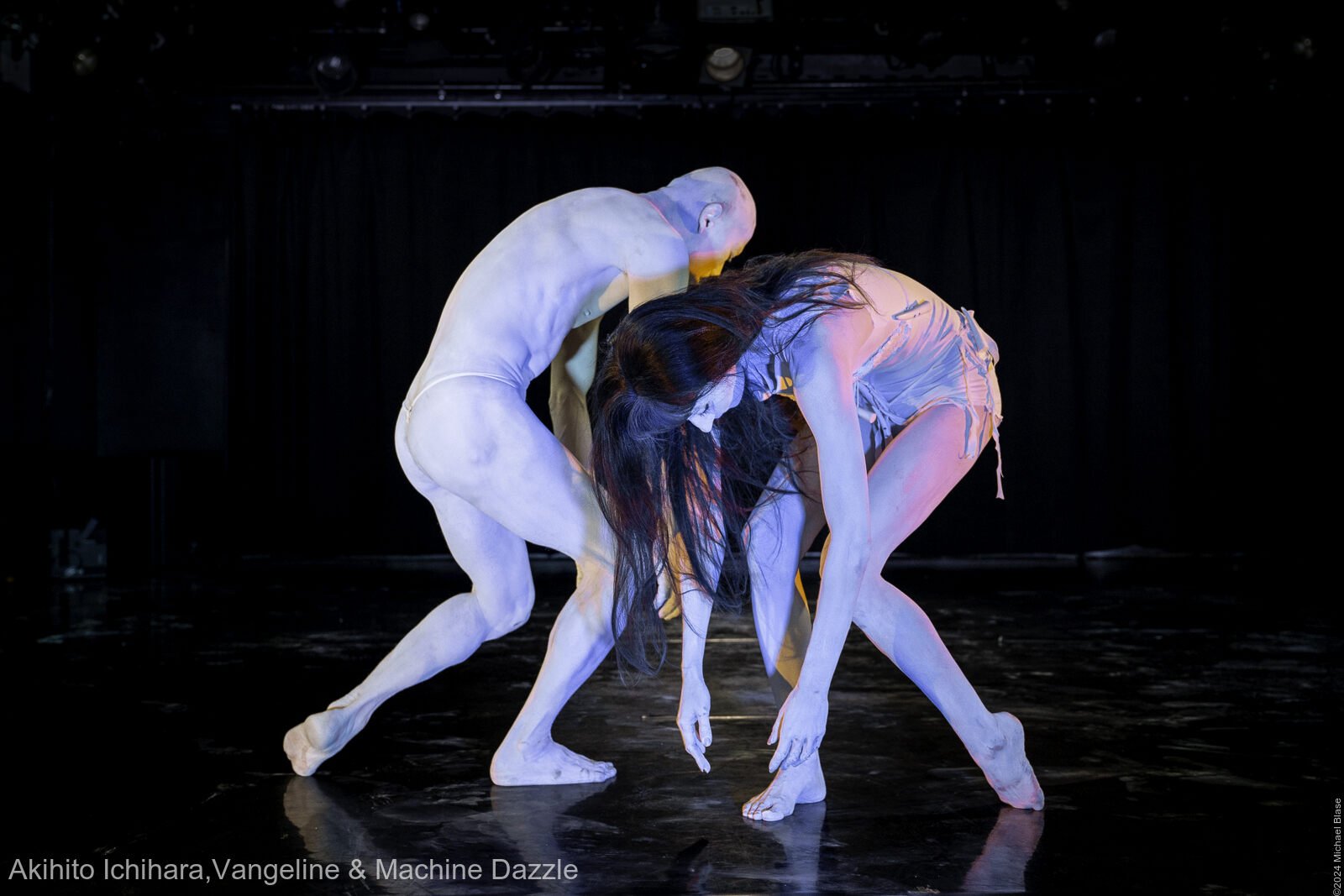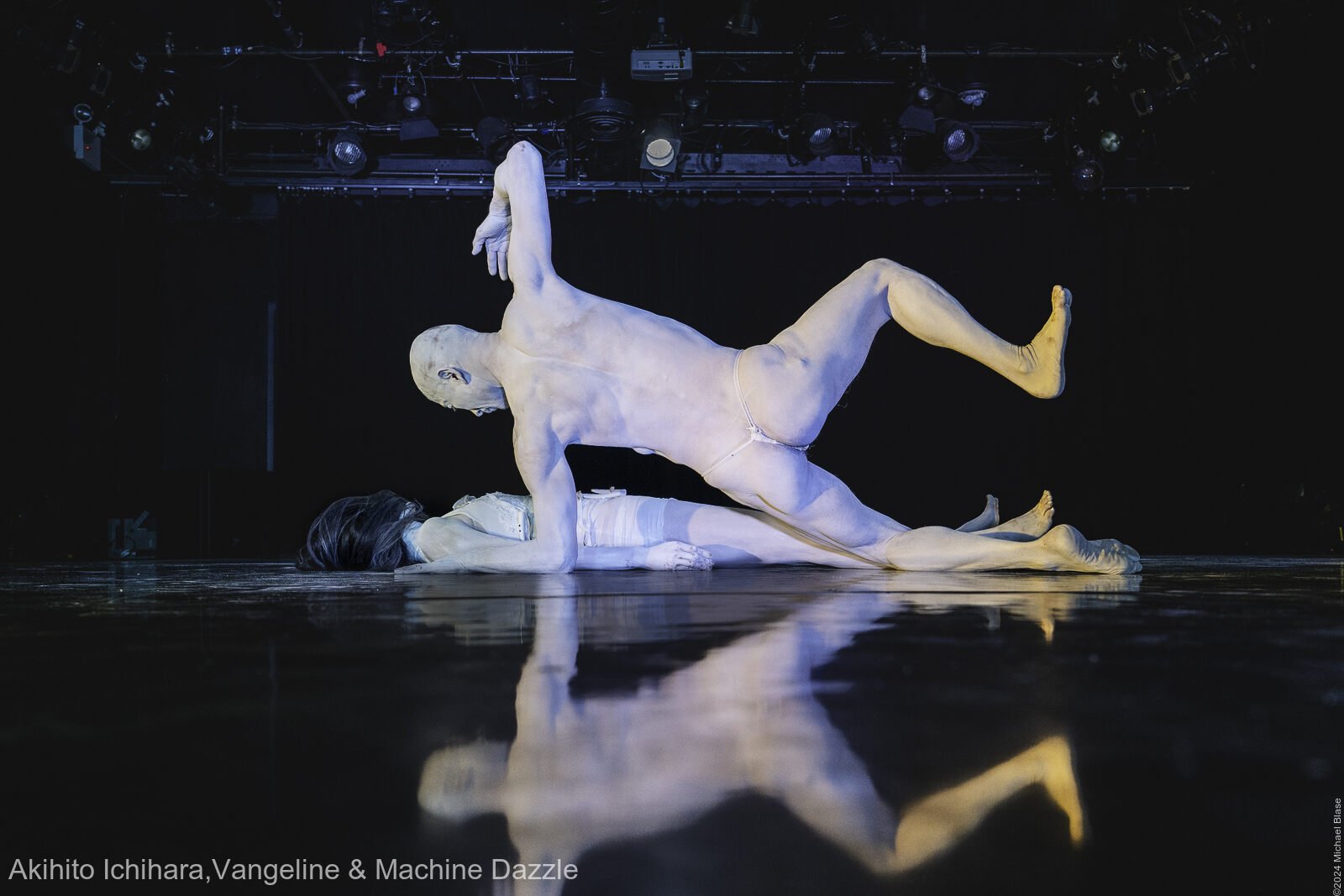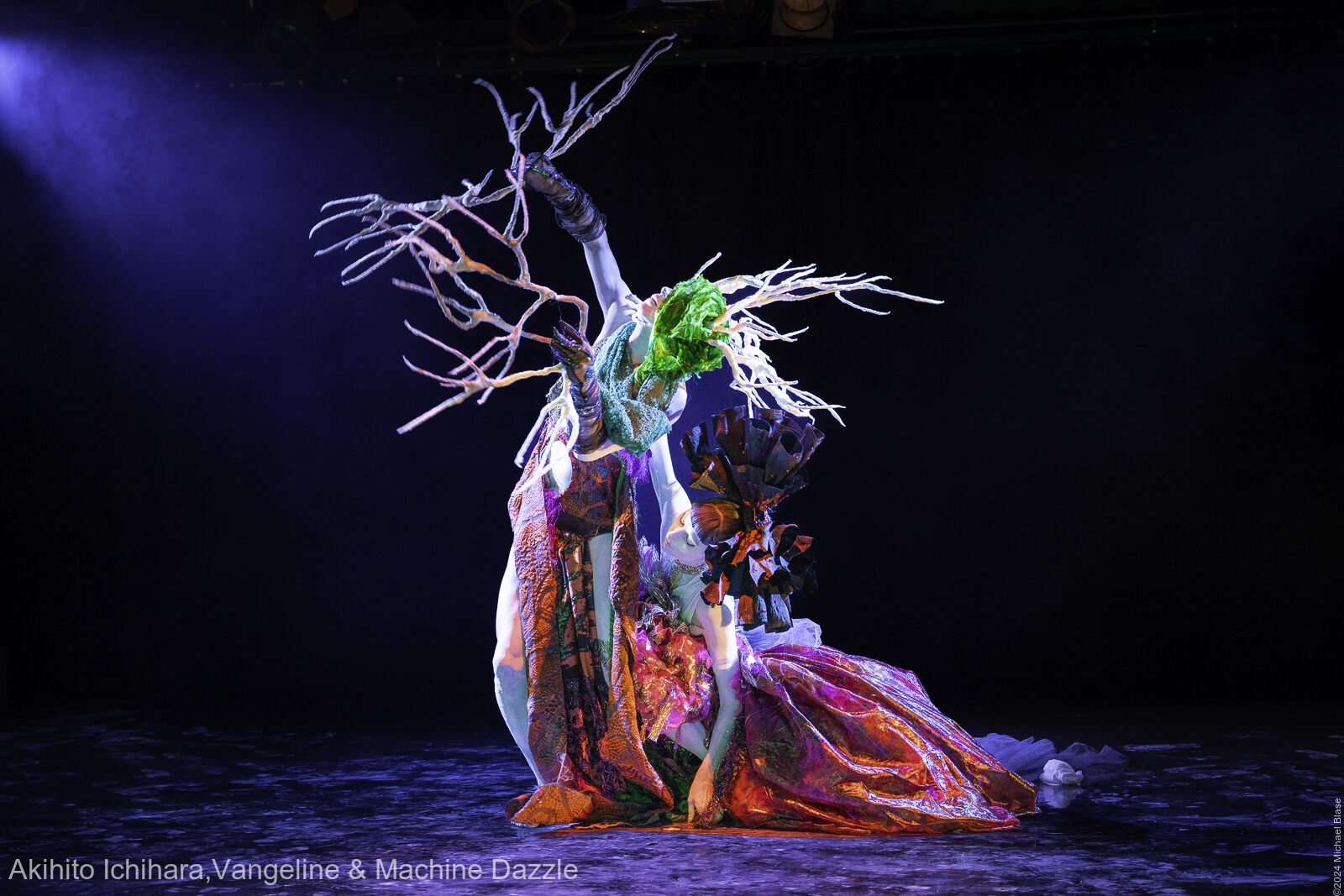Akihito Ichihara and Vangeline
MAN WOMAN
with costumes by Machine Dazzle
and composer Ray Barragan Sweeten
Vangeline Theater/New York Butoh Institute has partnered with ELF and the legendary New York artist Machine Dazzle to create a new duet titled MAN WOMAN, a collaboration between Butoh dancers Akihito Ichihara (Sankai Juku) and Vangeline.
Ichihara and Vangeline have developed MAN WOMAN during New York residencies at the New York Butoh Institute, Chelsea Factory, Monira Foundation, and Mercury Store in 2024.
MAN WOMAN will premiere in New York in Spring 2026.
Machine Dazzle has created original costumes for this piece and Ray Barragan Sweeten has composed the music for this 60-minute piece.
MAN WOMAN is a 60-minute interdisciplinary Butoh duet about the search for intimacy and the complexities of human connection. Choreographed and performed by acclaimed Butoh artists Akihito Ichihara (Japan) and Vangeline (U.S.), the work draws inspiration from the seminal 1960 photo book Man and Woman by Japanese photographer Eikoh Hosoe, which featured Tatsumi Hijikata—the founder of Butoh—and his wife, Motofuji.
MAN WOMAN uses these black-and-white photographs—saturated with ink and emotion—as both structure and departure point. Rather than reproducing the past, the dancers pass through a sequence of iconic poses from the book without physical contact, generating dynamic tension through negative space. Through a sequence of intimate, ceremonial vignettes, the dancers orbit one another—shedding layers and enacting rituals. The choreography becomes a meditation on longing, desire, and connection—culminating in a single, final touch. The piece invites audiences into a visually rich, emotionally resonant space—one that transcends language and cultural boundaries.
In homage to the legacy of Butoh and its disruptive origins, this work resists conventional binaries—male/female, East/West. Ichihara brings the precision and gravitas of Sankai Juku’s “classical” Butoh lineage, while Vangeline, informed by jazz, burlesque, and two decades of Butoh pedagogy and performance, brings contemporary nuance. Their collaboration is a rare cross-cultural encounter between two master practitioners at the height of their artistic maturity.
Central to the aesthetic of MAN WOMAN are the fantastical costumes by Machine Dazzle, a visionary queer artist whose work pushes the boundaries between performance, sculpture, and fashion. Machine’s concept—“Butoh Maximalism”—challenges minimalist assumptions by enveloping the dancers in lush, campy, baroque textures. Imagine creatures from an otherworldly Versailles stumbling through a forest—half human, half mythical. As the piece progresses, layers of costume are gradually removed, revealing the iconic Butoh white underneath. This symbolic unveiling strips away artifice to reveal essence, mirroring the performers’ emotional exposure.
The recorded score by Ray Barragan-Sweeten bridges centuries and sensibilities. Built from aleatoric compositions and re-sampled classical works (such as a reversed fragment of Bach), and drawing from the legacies of Pauline Oliveros and Elaine Summers, the music guides the dancers’ internal states, emphasizing timbre over melody and creating a soundscape that moves between stillness and intensity.
MAN WOMAN not only redefines Butoh for the 21st century—it also reframes it. In a form historically dominated by Japanese male artists, this piece foregrounds collaboration, gender equity, and queer aesthetics, while honoring Butoh’s roots in resistance and reinvention. It is also a challenge to ageism: choreographed and performed by artists in their 50s, it asserts that the peak of creative power does not reside in youth but in mastery, experience, and trust.
MAN WOMAN is a hybrid and visionary encounter. At its heart lies the question: how do we hold space for one another across distance, difference, and time? And in the tension of that space—across cultures, across disciplines, across bodies—we begin to find the answer.






Ichihara and Vangeline each come from different Butoh backgrounds; Ichihara from Sankai Juku, or what could be considered “classical” Butoh, while Vangeline’s 20 years of Butoh expertise was informed by her prior experience as a jazz and burlesque dancer. The artists imagine this encounter as cultural cross-pollination: the creation of something new and original choreographically, challenging aesthetic expectations and carrying Butoh into the 21st century.
Akihito Ichihara (“Ichi”) and Vangeline first met at the Sankai Juku summer camp in 2016 in Japan, and have long admired each other’s work. They decided to embark on a collaboration in October of 2023, only knowing that they wanted to work on a duet. In a stroke of inspiration, Vangeline asked Ichi’s thoughts on utilizing signature costumes created by her friend and collaborator of decades, the iconic queer artist Machine Dazzle. Ichi responded with unbridled enthusiasm, and thus, MAN WOMAN was born.
Machine Dazzle and Vangeline became friends as performers in the ‘90s at nightclubs in New York City. Having immense trust in Machine’s talent, skills, and vision, the dancers gave Machine carte blanche to create a costume for each of them, with only the directive that it must be ornate and flamboyant, with elements removed layer by layer until only Butoh white remained.
Machine’s costumes turn the dancers into sculptures, creating entirely new shapes that necessarily inform their movements. Vangeline and Ichi respond not only to one another’s choreographic vocabulary but also to the wearable art that adorns them. In turn, Machine modifies the costumes to facilitate the emergent dramaturgy of the piece.
Vangeline and Ray Sweeten build on a 20-year history of creative collaboration; Ray has composed Vangeline’s most important works, including The Slowest Wave. Ray Sweeten’s composition for MAN WOMAN spans from classical to electronic music and has been scored to have the flexibility to be performed by a string ensemble or performed to recorded music. Ray’s work builds on the legacy of American pioneers Pauline Oliveros and Elaine Summers, especially with regard to Oliveros’ writings on modes of attention and awareness.
All four artists are seasoned professionals who see this collaboration as an exploration, expanding their own artistry as they influence one another. The artists involved in MAN WOMAN are masterful, successful professionals embarking on this collaboration to elevate their craft, push artistic boundaries, create a legacy, and help shape the future of Butoh.
BIOGRAPHIES
Machine Dazzle
Machine Dazzle. Beloved downtown bon vivant and all-around creative provocateur Machine Dazzle has been dazzling stages via costumes, sets, and performance since his arrival in New York in 1994. An artist, costume designer, set designer, singer/songwriter, art director, and maker, Machine describes himself as a radical queer emotionally driven, instinct-based concept artist and thinker trapped in the role of costume designer, sometimes.
Machine designs intricate, unconventional wearable art pieces and bespoke installations. As a stage designer, Machine has collaborated with artists from the New York downtown scene and beyond – including Julie Atlas Muz, Big Art Group, Mx. Justin Vivian Bond, Taylor Mac, Basil Twist, Godfrey Reggio, Jennifer Miller, The Dazzle dancers, Big Art Group, Mike Albo, Stanley Love, Soomi Kim, Pig Iron Theatre Company, Opera Philadelphia, the Bearded Ladies Cabaret, the Curran Theatre, and Spiegelworld; and has created bespoke looks for fashion icons including designer Diane von Furstenberg and model Cara Delevingne for the 2019 Metropolitan Museum of Art Gala.
Machine’s costumes and sets were featured in Taylor Mac’s Pulitzer Prize-nominated A 24-Decade History of Popular Music. A documentary feature film directed by Jeffrey Friedman and Rob Epstein and co-produced by Pomegranate Arts will premiere at the Tribeca Film Festival in 2023.
In 2019, Machine was commissioned by Guggenheim Works and Process and The Rockefeller Brothers to create Treasure, a rock-and-roll cabaret of original songs including a fashion show inspired by the content.
Recent collaborations include the Catalyst Quartet on Bassline Fabulous – a reimagining of Bach’s Goldberg Variations at the Metropolitan Museum of Art and his debut collaboration with Opera Lafayette, for the historic premiere of the never-before-seen Rameau comedic opéra-ballet, Io.
Dazzle was a co-recipient the 2017 Bessie Award for Outstanding Visual Design, the winner of a 2017 Henry Hewes Design Award, and a 2022 United States Artists Fellow. He delivered a TED Talk at TED Vancouver in 2023.
Machine Dazzle’s work has been exhibited internationally. His first solo exhibition, Queer Maximalism x Machine Dazzle, was held at the Museum of Arts and Design in New York City in 2022. In April 2024, Machine received the TDF/Irene Sharaff Kitty Leech Ascending Artist Award in recognition for his success in the field of costume design. He was also awarded a 2024 EMMY for “Outstanding Costume Design for Variety, Nonfiction, or Reality Programming” for his work in the HBO documentary “Taylor Mac’s 24 Decade History of Popular Music.”
https://www.pomegranatearts.com/projects-and-artists/machine-dazzle
Akihito Ichihara
Akihito Ichihara is Japanese Butoh dancer (ELF, Sankai Juku).
Ichihara started acting in his teenage years. In the 1980s, he was greatly influenced by watching the renowned Butoh troupe Sankai Juku on TV, which inspired him to explore a greater range of physical expression on stage. In 1993, he majored in theater at Nihon University College of Art. He was moved to pursue a Butoh career in 1994; in 1996, he studied with Semimaru, a founding member of Sankai Juku. In 1997, he appeared as a dancer in an opera directed by Ushio Amagatsu, the artistic director and choreographer of Sankai Juku, and later joined Sankai Juku. Since then, he has been featured in Sankai Juku’s entire repertoire and most of Sankai Juku’s world tours.
Ichihara is very active in theater, dance, and Butoh. In addition to his solo projects, he has worked with the most significant butoh dancers and butoh troupes in the history of contemporary butoh. Since the 2005 recreation of “Kinkan Shonen” (which premiered in 1978), he has danced solos in many of Sankai Juku’s performances and has led the group dances as one of the principal dancers. He is also in charge of the design and production of the accessories dancers wear on stage.
Parallel to his work with Sankai Juku, he collaborates with various choreographers, directors, and dance groups worldwide. He is also a guest faculty at Okayama University Graduate School and a guest speaker at international forums.
In 2022, he founded the dance company “ELF” with young dancers. Since then, ELF has held workshops and presented works at renowned institutions and universities worldwide. In the spring of 2023, ELF went on tour in Latin America in Bogota, Colombia, and various locations in Mexico, Taiwan, and San Francisco. These activities received critical acclaim and repeat invitations. The company plans a world tour in 2024.
While many underground and grotesque expressions exist in Butoh, Ichihara, and ELF’s Butoh dance has deeply resonated with people worldwide. This dance is based on the “Sankai Juku Method,” a method accessible to everyone. By sharing this method, Ichihara aims to go beyond Butoh by developing a dance technique that can bring a higher level of excellence to professional dancers in ballet, modern, and contemporary dance.
Ichihara hopes to continue learning, collaborating, progressing, and contributing to the development of dance worldwide. He is interested in creating and directing various dance projects that transcend borders, cultural differences, and styles of expression.
Ichihara aims to develop a form of dance that promotes empathy and mutual respect. His goal is to do this worldwide, even between countries and cities that still bear the scars of war. He would like to contribute by acting as a bridge and connecting people across the borders despite their differences.
By sharing physical expressions, dancing, and empathizing with each other, the hope is to transcend borders and contribute to peace efforts worldwide. Based on this idea, ELF advocates a ”Dance Project without Borders.” @ak_ichihara
Vangeline
Vangeline is a teacher, dancer, and choreographer specializing in Japanese Butoh. She is the artistic director of the Vangeline Theater/New York Butoh Institute (New York), a dance company firmly rooted in the tradition of Japanese butoh while carrying it into the twenty-first century.
The Vangeline Theater/New York Butoh Institute is dedicated to advancing Butoh in the 21st century, with a particular emphasis on education, social justice, research, and archiving.
The Vangeline Theater/New York Butoh Institute reaches out to the New York and international community by offering public Butoh classes, workshops, and performances through collaborations with international and national Butoh artists. Their socially conscious performances tie together butoh and activism; addressing issues of gender inequality and social justice. The New York Butoh Institute Festival elevates the visibility of women in butoh, and the festival Queer Butoh gives a voice to LGBTQIA+ butoh artists.
The Dream a Dream Project, an award-winning, 18-year running program brings Butoh dance to incarcerated men and women at correctional facilities across New York State. "The Dream a Dream Project" contributes to the rehabilitation of New York's incarcerated population. Overall, these programs promote equity, diversity, and inclusion in the field of butoh.
Vangeline firmly believes that Butoh can be an instrument of personal and collective transformation in the 21st century. This transformation comes from holding a mirror to each other and integrating our many facets–the beautiful and the ugly; and from reintegrating the forgotten of our society into our midst.
Vangeline’s choreographed works have been performed in Chile, Hong Kong, Germany, Denmark, France, the UK, Hong Kong, and Taiwan. She is a 2022/2023 Gibney Dance Dance in Process residency and the 2022 National Endowment for the Arts Dance Award winner. She is also a 2018 NYFA/NYSCA Artist Fellow in Choreography for Elsewhere, the winner of the 2015 Gibney Dance Social Action Award and the 2019 Janet Arnold Award from the Society of Antiquaries of London.
Her work has been heralded in publications such as the New York Times (“captivating”) and Los Angeles Times (“moves with the clockwork deliberation of a practiced Japanese Butoh artist”) to name a few. Film projects include a starring role alongside actors James Franco and Winona Ryder in the feature film by director Jay Anania, 'The Letter" (2012-Lionsgate).
In recent years, she has been commissioned by triple Grammy Award-winning artists Esperanza Spalding, Skrillex, and David J. (Bauhaus). She is the author of the critically-acclaimed book: Butoh: Cradling Empty Space, which explores the intersection of Butoh and neuroscience. She pioneered the first neuroscientific study of Butoh (“The Slowest Wave”). She is featured on BBC’s podcast Deeply Human with host Dessa (episode 2 of 12: Why We Dance). She is also the host of the podcast Butoh Musing With Vangeline. https://www.vangeline.com
Ray Barragan Sweeten
Ray Barragan-Sweeten (b. 1975) is a visual artist & sound maker based in New York and Rhode Island. He has performed and screened works at Moma/PS1, San Francisco Electronic Music Festival, New York Film Festival, Anthology Film Archive, Issue Project Room, Participant Gallery, Microscope Gallery, The Kitchen, Roulette, and toured throughout Europe as a member of Fabrica Musica. He has released music as f13 on Beige Records as The Mitgang Audio on Suction Records. In 2010 he co-founded DataSpaceTime with visual artist Lisa Gwilliam and has exhibited, performed, and screened works at Centre Pompidou, Parish Museum, City Center NY, Microscope Gallery, AS220, Next Festival at BAM, Florida Atlantic University, and Cica Museum. He has taught at Guggenheim Museum and was guest artist faculty at Sarah Lawrence with L. Gwilliam. DataSpaceTime is represented by Microscope Gallery in NYC. www.raysweeten.com
Photos below from the Book Man And Woman by Eikoh Hosoe- Courtesy the Eikoh Hosoe Archives
This program was supported in parts by the Japan Foundation New York, the New York Department of Cultural Affairs, Chelsea Factory, Mercury Store, the Monira Foundation, and the New England Foundation for the Arts.
ALT TEXT
Performer Vangeline, painted entirely in white and wearing a sculptural costume by Machine Dazzle, kneels on a dark stage beside fellow performer Akihito Ichihara, who sits on the floor. Her arm gently cradles his head, which is adorned with a dramatic tangle of sculptural tendrils. Both performers are covered in white body paint, creating a spectral, sculptural effect. The pose—tender and protective—is inspired by a photograph from Man and Woman by Eikoh Hosoe, echoing themes of intimacy, gender duality, and surrender. The black stage floor is streaked with white pigment, enhancing the surreal atmosphere. From the 2024 performance MAN WOMAN, photographed by Michael Blase.
In a strikingly intimate moment from MAN WOMAN (2024), performers Akihito Ichihara and Vangeline stand face to face under dramatic stage lighting. Both are painted in pale white tones, their skin glowing against a black background. Akihito Ichihara, nude from the waist up, gently embraces Vangeline at the waist. Vangeline, dressed in an ivory-toned sculptural costume by Machine Dazzle, leans forward so that their foreheads nearly touch, their faces aligned in a moment of intense stillness and emotional tension. The closeness of their bodies, coupled with their impassive expressions, evokes themes of duality, intimacy, and transformation. Photo by Michael Blase.
In a serene moment from MAN WOMAN (2024), Akihito Ichihara and Vangeline lie flat on their backs on a black stage, bodies parallel and painted entirely in white. Akihito’s body is in the foreground, fully extended and motionless, while Vangeline lies slightly behind him, her face visible just above his shoulder. Both are illuminated by a gentle spotlight, creating a soft glow on their skin and a luminous reflection on the glossy floor beneath them. Vangeline wears a pale, sculptural costume by Machine Dazzle, while Ichihara appears minimally clothed. The image evokes stillness, surrender, and unity between two bodies in repose. Photo by Michael Blase.
A video of the same dancers in the same costumes behind the scenes in a large dance studio.
Two sculptural photos in black and white of a man’s elbow holding a Japanese woman’s head, and a picture of a woman’s contour with men’s forearms and fists planted next to her body in the ground. Photos By Eikoh Hosoe.








